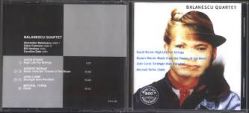 The Balanescu Quartet is a Romanian avant-garde string quartet founded in 1987 by Alexander Bălănescu that achieved fame through the release of several complex cover versions of songs by the German experimental electronic music band, Kraftwerk. The quartet is mainly notable for its very distinctive style of music, which encompasses odd time rhythms, sound dissonance and complex arrangements. The group has performed multiple works with a variety of other artists, including David Byrne, Gavin Bryars, Michael Nyman, Rabih Abou-Khalil, Kevin Volans, Hector Zazou, and Spiritualized.
The Balanescu Quartet is a Romanian avant-garde string quartet founded in 1987 by Alexander Bălănescu that achieved fame through the release of several complex cover versions of songs by the German experimental electronic music band, Kraftwerk. The quartet is mainly notable for its very distinctive style of music, which encompasses odd time rhythms, sound dissonance and complex arrangements. The group has performed multiple works with a variety of other artists, including David Byrne, Gavin Bryars, Michael Nyman, Rabih Abou-Khalil, Kevin Volans, Hector Zazou, and Spiritualized.
From the album liner notes:
High Life for Nine Instruments was commissioned by a festival called New Music America, an annual performance series that takes place in various "host" cities and which spotlights mostly "New Music," as it is sometimes known." Other people call it noisy, boring, or difficult. And sometimes those are the people who like it!
When I participated in NMA in 1980 in Minneapolis, performance art, "minimalism" and New Age noodling were making big in-roads into a scene that had been, for better or worse, are insular and academic. My piece, for a dozen strings and me as timekeeper, was on a programme with Philip Glass, whom everyone there was familiar with. His music was "popular" with serious musicians and rockers like myself. It was, and still is, I guess, a "crossover" act. I was crossing over, maybe, from the other side.
In the late Seventies, early Eighties I had been listening to a lot of West African popular music. I heard the electric guitar being reinvented. Freshness! I love the bastard quality of all "popular" musics, and West African styles are no different; elements of Country and Western, Rhumba, Rhythm & Blues, and missionary church singing fuse with overlapping drum patters. Rock and Roll had similar unholy birth, so I somehow felt I was on familiar ground. Being a guitar player myself, I zoomed right in on the sparkling overlapping guitar patterns, like half a dozen funky solos all at once - and most importantly, they were all tight with the groove.
John Miller Chernoff's book African Rhythm and African Sensibility articulated for me what was going on in this music. I wanted to know why it felt so good. I felt that if I could get with that attitude, I might re-organize my music, and inspire the musicians I was working with, without copying any of the Africans' licks or styles directly. I was hoping to apply the African philosophy, at least my screwed up understanding of it, to the funky rock I was already involved in. My assumption was that it would **** with my music until something new, and not recognizably African, resulted.
So, to make a long story short, I used my guitar to wrote all the lines for strings, over a vaguely High-Life groove. It's not counterpoint, it's not traditional harmony (although it is consonant) and the Balanescu Quartet truly swings. (Some of the players had to overdub their parts; there are too many lines for a quartet, even one this good.)
Recent New Music Americas have been infused with a new development: multiculturalism. At last the full spectrum of creativity that surrounds us is beginning to be acknowledged. Things will never be the same.
-David Byrne


